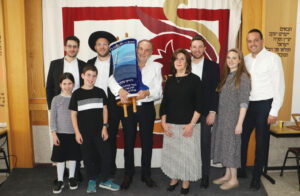A few months after 14 May 2022, a curator sought out three local artists. The resulting exhibition, Before and After Again, is thought to be the first of its kind
Two years ago, a white supremacist drove 200 miles to Buffalo, New York, and opened fire in a grocery store in the city’s predominantly Black East Side neighborhood, killing 10 people and injuring three.
Though the Tops Friendly Markets where the racist mass shooting took place has been remodeled, and most of the country has forgotten about the violence that occurred on 14 May 2022, Buffalo’s East Side is forever changed.
“There’s collective grieving for what was done to our community,” Julia Bottoms, a local artist, said. “I’d say there’s outrage, too, a lot of emotions: anger, outrage, frustration, sorrow. We are still processing as a community.”
A few months after the shooting, Aaron Ott, the curator of public art at the Buffalo AKG Art Museum (formerly known as the Albright–Knox Art Gallery), sought out a trio of local artists and creators to commemorate the tragedy: Bottoms, with whom Ott had previously collaborated on Buffalo’s Freedom Wall, a collection of murals of civil-rights leaders; the writer and curator Tiffany Gaines; and Buffalo’s first poet laureate, Jillian Hanesworth.
The resulting exhibition, Before and After Again, is thought to be the first of its kind, one that deals with mass gun violence and that aims to help viewers “disrupt the caustic systems that threaten our trust, faith and love for one another”, according to the exhibition’s statement.
Not wanting to be guided by their own feelings about the Buffalo tragedy, Bottoms, Gaines and Hanesworth instead spent 15 months connecting with victims’ families and others in the East Side community. Through dozens of interviews and conversations, the artists collected stories and information that shaped the exhibit, which opened earlier this year and is on view at the Buffalo AKG Art Museum through 30 September. It combines poetry, prose, paintings and other works of art, all of which aim to encourage viewers to ensure loved ones are not forgotten, while creating a space for dialogue and change.
“We wanted to know a little bit more about the lives of their loved ones. What made them laugh the hardest? What was their favorite recipe that they would make?” Bottoms said. “Just those things that create a beautiful life. Within the work, there’s the idea of memory, of what’s present and what’s lost when somebody’s taken so suddenly and so tragically.”
Bottoms said she tried to translate the family members’ interviews visually, by conveying emotions that would be relatable to audience members who may not have known the victims. She painted portraits and still lifes, Hanesworth wrote 12 poems, and Gaines wrote an essay that is on display in the exhibition space.
“Everybody can think of their loved one and what made them laugh. Everybody can think of a recipe, or a smell that brings back the memory of that person,” Bottoms said. “Something that was important for me and the families was not making somebody monumental or a symbol of something. It was so important to keep that humanity and their individual stories and essence within the portraits.”




